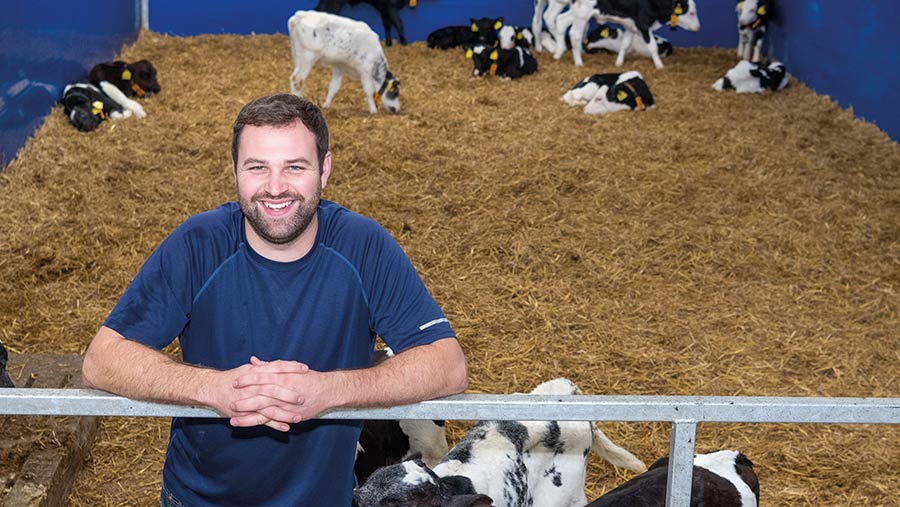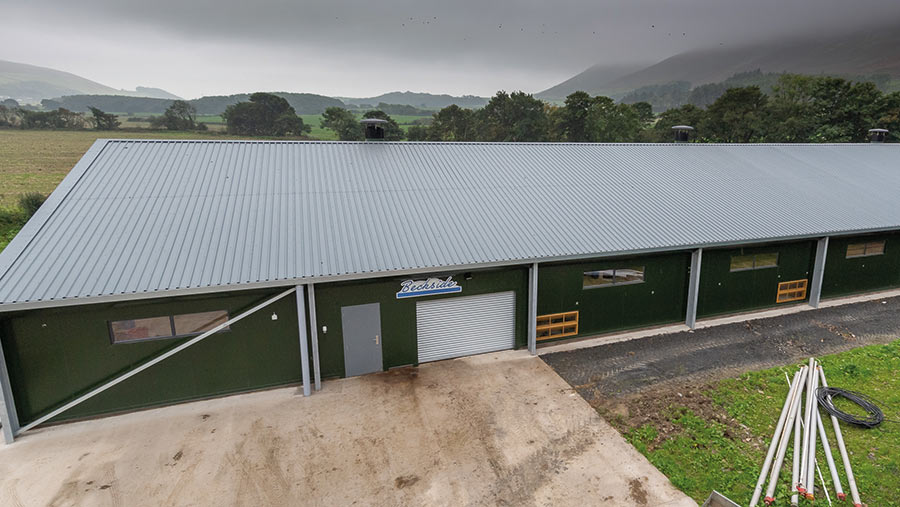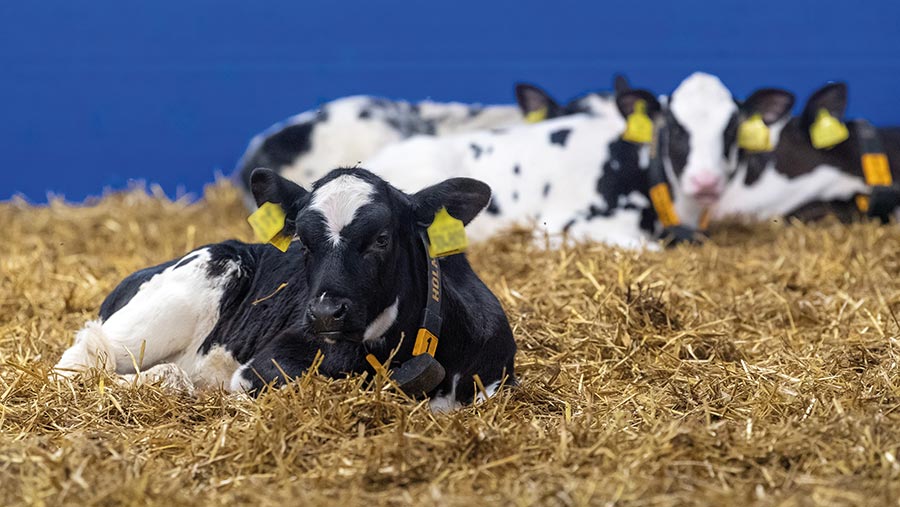WIYLS visits a £225,000 calf shed modelled on broiler design
Pneumonia cases are now few and far between and calf growth rates are exceeding 1kg a day since a climate-controlled calf unit, similar to a broiler house, was erected at Beckside Farm, Cumbria.
The decision by the Morris-Eyton family to invest in a new calf shed came about when they expanded the herd from 250 cows to 400 in 2019.
The original steel-framed calf building was already creaking at its seams. With more heifers being retained for breeding, the expansion was beginning to affect productivity.
Patrick Morris-Eyton, who farms with his father, Robert, and mother, Rowena, talks about the new build.
See also: WIYLS goes inside Duchy College’s £3.6m dairy unit

Patrick Morris-Eyton © Wayne Hutchinson
When did you invest in the new shed?
We first started the building in April 2021, and it was completed by the end of June.

© Wayne Hutchinson
Why did you invest in a new shed?
When we expanded the dairy, we increased cow numbers by 150 and retained a lot of heifers – we were calving 200 heifers a year.
This put a lot of pressure on the existing building. The new facility can house 136 calves, compared with 75 in the old shed.
How did you design the unit?
We knew we wanted a climate-controlled unit because of the high humidity – we get more than 1,500mm of rain a year.
However, because of Covid, we couldn’t travel to look at a similar unit because there was nothing of its kind that we are aware of in the UK.
My dad was consulting for someone who had broilers, and the building looked like the sort of thing we were after. We thought, chickens are fickle, so if it’s good enough for them, it’s good enough for our calves.
Who was involved in the construction?
The shed was made by Powells in Leominster, Herefordshire, which also made all the internal fixtures such as the pens and gates, although they were designed by us.
The ventilation and LED lighting came from JF McKenna, feed stations from Holm and Laue, and the electricals were done by Dan Taylor.
Tell us about the build specifications
The building is 18m wide x 54m long and was designed as a steel broiler shed. Because of this, all the steel supports are outside to ease cleaning down.
Walls are insulated with 100mm of insulation, the gable ends 150mm, and the roof 200mm.
LED lighting is on a 16-hour day, then dims and turns off entirely at night. It creates 200 lux at calf height.
The shed has 16 individual fully plastic slatted pens which are straw bedded. The slats are from Rimco. Each pen measures 2m x 1.5m, which is double the Red Tractor specification.
Calves are housed in individual pens until seven days old.

© Wayne Hutchinson
The shed also contains six solid-sided group pens, each measuring 12m x 6m which can house up to 20 calves from seven to 75 days old on an all-in-all-out basis.
The sides of the individual pens and the large group pens are all solid.

© Wayne Hutchinson
The floors are solid concrete with a gentle 2deg slope to the middle of the pen, where there is a central drainage channel.
The drainage pipe has gravel on top, which helps filter out any straw. This drains straight into the lagoon.
The back half of the pen is bedded with fresh straw every other day.
We also decided to raise the feed area by 20cm to avoid straw building up. The raised area is slatted to aid with cleanliness, with a sump housed underneath.
How do you feed calves?
They are fed individually with milk from their mother for the first three days and then move onto a calf milk replacer after this. They are fed twice a day.

© Wayne Hutchinson
Calves are fed milk replacer using automatic milk feeders. We have one Holm and Laue Calf Expert feeder with a hygiene station that weighs calves as they enter and tracks their growth rates.
The feeder also cleans the teats between each feed. This cost about £20,000, but we secured a Countryside Productivity Small Grant, which paid 40% of the price.
The remaining feeders are older Holm and Laue models that automatically mix the feed according to a specific feed curve for heifer calves and beef calves – which are housed together.
The group pens also contain 1.5m-long hangover feed troughs, and calves have access to fresh water.
How is the shed ventilated?
It is ventilated using a negative pressure system. This means fresh air is drawn in through four automated vents on the side of the shed.
The solid boards on the fronts of the pens then force that fresh air to mix, along with four circulation fans, and the three chimney fans situated in the roof suck the air out.
This means there is a continuous flow of clean air through the building. It also means you don’t need the stack effect, which can be hard to generate due to the size of calves.
The main passageway is 6m wide, which is the required width needed to get the air circulating correctly.
Three wall-mounted heaters help keep the temperature and humidity constant. The target is for the temperature to be 15-17C and the humidity maintained at 60%.
Heat comes from the heat exchange unit in the parlour and electricity from hydropower on the farm.
What was the initial budget, and did you stick to it?
We budgeted about £200,000 and went over at £225,000 for the shed and internals.
What’s your favourite feature?
The ventilation system. We don’t have the same cold and heat stress we had in the old shed.
What has been your best buy, and why?
We like the automatic calf feeders, especially the newest model, as we can track the weights of all calves and milk consumed.
Has any design aspect helped ease management?
The ventilation hasn’t only improved animal health and welfare – it reduced bedding costs because the improved humidity means straw stays drier.
In the old shed, we used one bale every other day for all the calves, and now we are using two bales a week with more calves.
Has the calf shed improved calf growth and health?
Yes, massively. Pneumonia was a real problem in the old shed. As soon as it rained, we would get cases of pneumonia accounting for about 25% of calves annually.
We no longer use calf jackets, and we’ve stopped vaccinating for pneumonia.
At their best in the previous unit, calves would be achieving 0.9-0.95kg a day, but as calf numbers began increasing, this dropped to 0.8-0.85kg a day. Now we are reaching over 1kg a day.
Have there been any teething problems?
It has been a bit of a challenge getting the settings right in the ventilation system, and the individual pens need more air sucked out than the large group pens. However, we are fine-tuning it now.
